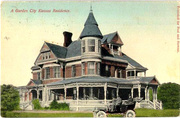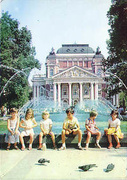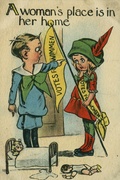Jeff L. Rosenheim, curator of The Metropolitan Museum of Art’s Department of Photographs, talks about “Walker Evans and the Picture Postcard,” an exhibit opening in February 2009 featuring 9,000 postcards from Evans’ personal collection. Evans collected postcards his whole life, a pursuit which heavily influenced his artistic style as a photographer. Rosenheim has been a curator at The Met for 21 years and has published two books on Walker Evans: “Walker Evans: Unclassified” and “Walker Evans and The Picture Postcard.”

Woolworth and Municipal Buildings from Brooklyn Bridge, 1910s, Unknown Artist, The Metropolitan Museum of Art, Walker Evans Archive, 1994
In 1994, I had the great pleasure of acquiring the complete archive of Walker Evans for the Metropolitan Museum. The archive is quite vast, including 30,000 black-and-white negatives and about 10,000 color transparencies. It includes collections of his business and personal correspondence, both letters he sent as well as those he received. It also includes his library and his collections. He had works of art by other artists, and a lot of vernacular material, including metal and wood advertisements, signs, clippings from the Picture Press, printed ephemera, and a very large postcard collection, which he had begun as a child and collected for more than 60 years.
This exhibition argues that as an artist he was greatly influenced by the simple style and artless quality of the postcards and their generic way of describing the world. Evans is somewhat the progenitor of the documentary tradition in American photography, and he got that from looking at Mathew Brady and Civil War photographs in general. He got that from literature. He got that from his own travels and understanding of our culture. He got that from thinking about photographic history, and from a lifetime of appreciation of the picture postcard.
Collectors Weekly: How many postcards are on display at the exhibit?
Rosenheim: About 700. It’s as large a postcard exhibition as anyone I know has ever seen. Postcards are objects, not just images, and this is a very object-based exhibition. What’s interesting to me is how the cards themselves were organized, classified, and written about by a great American artist.
Walker Evans published one of the first serious commentaries on the picture postcard outside of the collectors’ world, in 1948 in Fortune magazine. We’re showing the three portfolio essays he wrote and published on the picture postcard – two articles in Fortune magazine and one in Architectural Forum. We’ll also be showing a very important public lecture on postcards he gave in 1964 at Yale University. We have a recording of the talk and I’ve transcribed that and matched the cards that he showed. Later in life when Evans was invited to lecture on his own work, he often declined and instead lectured on his interest in the picture postcard.
Collectors Weekly: How did Evans start collecting postcards?
Rosenheim: He was born in St. Louis and grew up in suburban Chicago, eventually moving to Ohio. As a child, when his family would travel to visit relatives, he went to the five-and-dime stores and bought all the local cards he could. He methodically organized them and spent a lot of time systematizing his interests. I don’t know of another major artist who classified and organized postcards quite the same way Evans did.

Men’s Bathing Department, Bath House, Hot Springs National Park, Ark., 1920s, Unknown Aritst, The Metropolitan Museum of Art, Walker Evans Archive, 1994
He was a well known artist and had many interesting friends – writers, other artists, editors, businessmen – and they all knew he was collecting, so they helped him. They sent him cards and he sent cards to them and then collected them back. He did it pretty much his whole life. He had a full-time career as an artist and as a teacher late in life and as an editor at Fortune magazine for 20 years in the ‘40s, ‘50s, and early ‘60s. Postcard collecting was just something he did for himself and it informs his work.
He liked the earliest postcards. He preferred high quality reproduction cards, but also appreciated the ones that were printed locally in small towns all across the country. The largest section of his collection is everyday street themes from Brooklyn to Bakersfield, literally just looking down the street. But he also collected state capitols, beach themes, hotels, and seascapes. He collected things that he categorized as curiosities. He collected comic cards.
In every category, there was a healthy dose of editing, he didn’t just collect one of each card. He collected multiple cards if he liked them, and he was collecting them when they were new. When he was old, they had become classics. He came of age in the postcard era, and he ended up with 9,000 or more cards, along with his collection of driftwood and tin-can pull tabs and signs and printed ephemera. They were really important for him.
Collectors Weekly: Did he display the cards?
Rosenheim: When people came to visit, he shared his cards with them. Everybody knew he was collecting cards. He collected cards that were sent to all of his friends, and you can just imagine him swiping them from the front-hall table for his collection, because they’re addressed to all the most important people in his cultural circle. He didn’t know the sender, but he knew the receiver.

Birds Eye View of Lincoln, Neb., ca. 1906, Unknown Artist, The Metropolitan Museum of Art, Walker Evans Archive, 1994
I don’t know exactly how he displayed them, but they were very present. He had his collection of vernacular ephemera and street signs surrounding him – hand-painted wood signs, porcelain signs, baked enamel signs, and advertisements. We have all of those here at the museum. In fact, if you get a copy of my book, Walker Evans: Unclassified, you’ll see a whole chapter on his sampling of postcards and street signs.
Evans used a pretty standard taxonomy to organize his cards. He kept them in general subject categories – street scenes, beach scenes, comics, state capitols, courthouses, etc. – with some exceptions. He did keep a category on London. His collection is primarily (but not exclusively) an American collection. He did travel to London a lot in the 1950s and early ’60s, for work and pleasure. He also had a subject category called Riviera, and I think that was because there were a lot of cards made in the Riviera that came to the U.S. It’s where Americans went in the ‘20s.
He doesn’t have state categories, although he spent a lot of time in Connecticut, New York, and Massachusetts. There were tons of Maine and New Hampshire and Vermont summer hotels, but they’re all just under summer hotels. His taxonomy is consistent with the taxonomy that he used in his own work with the camera. The more general it is, the more specific each picture is.
Collectors Weekly: How did his postcard collecting impact his own work?
Rosenheim: There are many examples. The scholarly purpose of the book is to attempt to answer that question, as well as to share great postcards with the public. By 1936, Evans was so influenced by the postcard that he started actually printing his own sheet film negatives. He was one of those guys that used a Leica to take street pictures that made snapshots, but he also used a view camera for his major work, like most of the images from Let Us Now Praise Famous Men, his great book with James Agee.
Evans’ postcard collecting preceded his picking up the camera.
In 1936, he was on a leave of absence from the New Deal, and he took his 8-by-10-inch sheet film negatives that he had to submit to the New Deal and printed them on special Kodak postcard-format photographic paper.
There are two types of postcards. There are real photo postcards, which are made on silver emulsion paper. Those are generally not published in the traditional sense and they have their own collectible market. Then there are printed cards that are lithographic cards which were almost always colored, although the original images were black and white. Evans, just as an aside, preferred the printed cards, the more democratic tradition and the one that represented an effort to record the world in a very interesting way, more so than the real photo cards, which had a much smaller distribution.
So in 1936, Evans used his sheet film 8-by-10 negatives to make a special set of about two dozen images on postcard format paper. It’s basically reducing the image, not by an enlarging process. In other words, the whole image doesn’t get printed on that little postcard; it’s cropped. He produced these and he tried to get the Museum of Modern Art to publish them as a conceptual postcard set of his photographs.
The museum went so far as to get prices – and it’s during the Depression, of course – and in the end they didn’t do it. But Evans used that association with the Museum of Modern Art to get what he really wanted, which was a big exhibition of his photographs, and he included some of these postcard format photographs in the exhibition. In fact, American Photographs, which is the most important monographic exhibition of photography in the 20th century and the first major show of a living photographer at MoMA, begins with a postcard format.
Another indicator of the influence his collecting had was that he started writing about, commenting on, and publishing postcards, first in 1948 at Fortune magazine. He started working at Fortune a few years earlier, and when he earned his stripes, he convinced the editor in charge of the portfolio section to let him do this. They’re all drawn from his collection, except for two cards, which are from the picture collection at the New York Public Library, which collected postcards. Evans helped build their collection of postcards by sending them postcards when he was traveling.
If you take a look at that Fortune article (I’ve published it in facsimile in my book) you’ll see something interesting: the postcards are reproduced one-to-one life size and he added a shadow so that they shadow off the page. This is pre-Photoshop, of course. It’s a very interesting thing to have done. He wanted them to have their objectness.
So the influence is the quotidian subject matter and everyday artless style of the postcards. It influenced how he traveled and how he titled his work. He liked the taxonomy of titling that was used in postcards. He liked the idea that it was a democratic tradition, that there was a photograph he believed to be made in every small town and large town in America.
He believed that the idea of the postcard was a way of recording aspects of American culture that were not recorded in any other medium. These were greatly important to him. Later on in life he lectured on the postcard. He showed postcards. He talked to people about postcards, and the last book he wanted to do of any major note was going to be a book on his postcard collection.
Collectors Weekly: Do you consider collecting an art form? Would Evans have?
Rosenheim: Collecting is a cultural activity that certain types of artists have always been interested in. It is to some a requirement for an artist. In other words, it’s one way that artists interact with the world.
Vladimir Nabokov, the author of Lolita and many other wonderful books, collected butterflies, and his collection is at Harvard’s Museum of Comparative Zoology. Degas collected old master paintings and contemporary paintings. He owned an El Greco and Manet and Cezanne and Gauguin and hundreds of Delacroix drawings in oils. Andy Warhol collected everything: cookie jars and paper ephemera and Victorian shoes and body shawls. Caroline Kennedy’s wedding cake was in his collection.
The fact that Evans’ collecting of postcards precedes his picking up the camera in itself is extremely interesting. What it means is that it entered his cultural consciousness probably before any other item.
Collectors Weekly: Were there other famous artists, contemporaries of Evans, who collected postcards?
Rosenheim: The great Swiss photographer Robert Frank, the subject of a major exhibition right now at the National Gallery, is a good 20 years younger than Evans and was his protégé. Frank is a very serious postcard collector, but his postcards are very different from Evans’. He didn’t methodically categorize or classify them like Evans did. He has never written about them, but he did publish a book of postcards that people sent to him. It was basically the correspondence he was interested in, but it’s a serious collection. The contemporary artist Stephen Shore is very influenced by postcards as well and has collected them.
(All images in this article courtesy the Metropolitan Museum of Art)



 Attending the Theatre, Via Postcards
Attending the Theatre, Via Postcards
 When Postcards Were the Social Network
When Postcards Were the Social Network Attending the Theatre, Via Postcards
Attending the Theatre, Via Postcards War on Women, Waged in Postcards: Memes From the Suffragist Era
War on Women, Waged in Postcards: Memes From the Suffragist Era PostcardsPostcards, sometimes spelled out in two words as "post cards," emerged duri…
PostcardsPostcards, sometimes spelled out in two words as "post cards," emerged duri… Mari Tepper: Laying it on the Line
Mari Tepper: Laying it on the Line Nice Ice: Valerie Hammond on the Genteel Charm of Vintage Canadian Costume Jewelry
Nice Ice: Valerie Hammond on the Genteel Charm of Vintage Canadian Costume Jewelry How Jim Heimann Got Crazy for California Architecture
How Jim Heimann Got Crazy for California Architecture Modernist Man: Jock Peters May Be the Most Influential Architect You've Never Heard Of
Modernist Man: Jock Peters May Be the Most Influential Architect You've Never Heard Of Meet Cute: Were Kokeshi Dolls the Models for Hello Kitty, Pokemon, and Be@rbrick?
Meet Cute: Were Kokeshi Dolls the Models for Hello Kitty, Pokemon, and Be@rbrick? When the King of Comedy Posters Set His Surreal Sights on the World of Rock 'n' Roll
When the King of Comedy Posters Set His Surreal Sights on the World of Rock 'n' Roll How One Artist Makes New Art From Old Coloring Books and Found Photos
How One Artist Makes New Art From Old Coloring Books and Found Photos Say Cheese! How Bad Photography Has Changed Our Definition of Good Pictures
Say Cheese! How Bad Photography Has Changed Our Definition of Good Pictures Middle Earthenware: One Family's Quest to Reclaim Its Place in British Pottery History
Middle Earthenware: One Family's Quest to Reclaim Its Place in British Pottery History Fancy Fowl: How an Evil Sea Captain and a Beloved Queen Made the World Crave KFC
Fancy Fowl: How an Evil Sea Captain and a Beloved Queen Made the World Crave KFC
I too have a petty large collection of Real Photo post Cards (7,000) Since I love trains Many are of trains, stations, industry,plus street scenes,coast to coast And my own photography which began during the deprssion I bought a box camera at walgreens in Chicago in 1934 and developed in a basement stall. i’m still shooting photos at age 83, my images are from Chicago, Jazz, to Georgia in 1950 to New york and everywhere. thanks for listening.
Sandor Demlinger, please ensure that you have provided instructions for your photography and collections in your will. I’d love to see yhour photographs! I have been taking photographs since 1970 or so and have been putting most of them up on Flickr as a way of ensuring their longevity.
ATT: OLD SALT; As of today; 7/7/2016 I have posted many of my images on my FACEBOOK SIGHT. So you can look at them there. Also in the book, ‘ Destination Chicago Jazz. ” Pub by Arcadia in hard cover with writing by John Steiner CHECK Amazon books for other books by me. HOPE you enjoy this sight as I also write comedy on this that folks enjoy. Yeah i’m getting old almost 89 in Sept… Have a great day. Sandor
My wife Reva and I have been collecting Photographs and photo post cards for forty years and the numbers are in the thousands. We have several fine images by Walker Evans. But most are of the EARLY WEST, cowboys, Indians, old western town scenes logging,and railroading. Sandor Demlinger. I hope “OLD SALT” is still around.